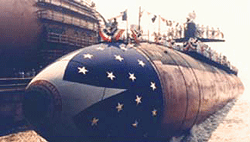|
 |
|
USS Providence - SSN-719
August 1984
|
USS PROVIDENCE (SSN-719) is faster than her predecessors and armed with highly accurate sensors and weaons control systems, and is armed with sophisticated Mk 48 anti-submarine torpedoes. PROVIDENCE is the first 688-class submarine equipped with the capability to vertically launch Tomahawk cruise missiles. Twelve vertical tubes in the bow compartment provide this additional capability. She is named for the capital city of Rhode Island and is the fifth ship to bear the name.
The original sloop PROVIDENCE was built in 1770 as the sloop KATY, a merchant. She carried guns to protect her against pirates. To protect shipping in the Narragansett Bay from British patrol and customs enforcing ships, the Rhode Island colonial legislature organized a Navy in May 1775 and KATY became the first ship of the first Navy organized in the colonies. In 1775, under Captain Abraham Whipple, the sloop fought the first at-sea action of the revolution, engaging a Royal Navy Schooner off Conainicut Point in Narragansett Bay. KATY, remamed PROVIDENCE became Rhode Island's first contribution to the Continental Navy. In 1776, John Paul Jones was given the sloop as his first command. This original PROVIDENCE fought against the enemy aggresively and successfully. She captured or sank forty ships.
The second PROVIDENCE, a frigate built in Rhode Island in 1776, ran the British Blockade of the Providence River on her maiden voyage. She was able to procure guns and supplies from France for Continental naval vessels still under construction. From 1779 to 1780 she served with honor as flagship to Commodore Whiple.
The third PROVIDENCE, an Army gondola, was attached to Brigadier General Benedict Arnold's command on Lake Champlain in 1776. She was heavily damaged at the Battle of Valcour Island.
The fourth PROVIDENCE, a Cleveland-class cruiser, was commissioned in 1945 and recommissioned in 1959 as a guided missile cruiser. She served as the flagship for the Seventh Fleet off the coast of Southeast Asia during the Vietnam conflict. This PROVIDENCE compiled a proud record of service, winning the Navy Unit Commendation from November 1966 to May 1968. She was decommissioned in 1978 and is mothballed in Washington.
Technology has dramatically changed the size and capabilities of naval warships since the original PROVIDENCE set sail against the British in 1775. The mission of this latest PROVIDENCE, however, has not changed significantly. That mission remains the protection of naval interests of the United States of America.
from "UNITED STATES NAVAL SUBMARINE FORCE INFORMATION BOOK" -- J. Christley;
and material provided by S.W. Howard